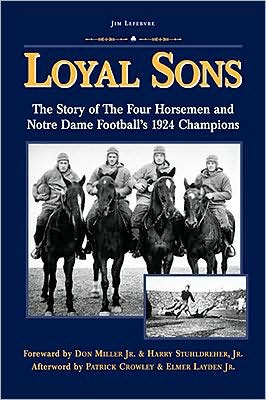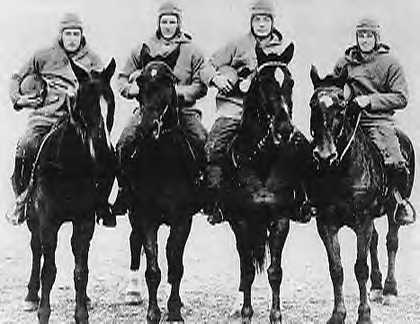|
| |
Back
to Articles Menu
Book Report: Loyal Sons
by
Randy Snow
Originally
posted on AmericanChronicle.com, Saturday, December 20, 2008
The new
book, Loyal Sons by author Jim Lefebvre, tells the story of one of the
most famous backfields in college football history, The Four Horsemen of Notre
Dame. Anyone who has even a passing interest in football has heard of The Four
Horsemen before, but just who were they?
 There
was quarterback/place kicker Harry Stuhldreher (#32) from Massillon, Ohio,
halfback/place kicker Jim Crowley (#18) from Green Bay, Wisconsin, halfback Don
Miller (#16) from Defiance, Ohio and fullback/punter Elmer Layden (#5) from
Davenport, Iowa. Back in the 1920´s, players did everything on the field.
Quarterbacks ran with the ball and halfbacks and fullbacks could also throw
passes. Punting, returning kicks and field goal kicking duties were all handled
by regular players, not specialists as they are today. They also had to play on
defense as well. To play football back then, you had to be able to do
everything. There
was quarterback/place kicker Harry Stuhldreher (#32) from Massillon, Ohio,
halfback/place kicker Jim Crowley (#18) from Green Bay, Wisconsin, halfback Don
Miller (#16) from Defiance, Ohio and fullback/punter Elmer Layden (#5) from
Davenport, Iowa. Back in the 1920´s, players did everything on the field.
Quarterbacks ran with the ball and halfbacks and fullbacks could also throw
passes. Punting, returning kicks and field goal kicking duties were all handled
by regular players, not specialists as they are today. They also had to play on
defense as well. To play football back then, you had to be able to do
everything.
Harry Stuhldreher was just 14 years old when he first met future Notre Dame head
coach Knute Rockne in 1915. Rockne had graduated from Notre Dame in 1914 and was
a Notre Dame assistant football coach at the time. He and his former college
team mate, quarterback Gus Dorais, were also playing for a pro football team in
Massillon, Ohio where Stuhldreher lived. The big game for Massillon at that time
was against the nearby Canton Bulldogs, which included Jim Thorpe.
Jim Crowley´s high school football coach was Curley Lambeau, who went on to
organize the Green Bay Packers of the NFL. Lambeau played football at Notre Dame
for one season in 1918. That was Rockne´s first season as head coach at the
school and Lambeau shared the backfield with a player who would become a Notre
Dame legend himself, George Gipp. It was Lambeau who encouraged Crowley to
attend Notre Dame, believing that he would be a good addition on Rockne´s team.
Don Miller was the class president at Notre Dame during the 1924-1925 school
year. He had four older brothers who all attended Notre Dame at one time or
another, beginning in 1906, and they all played football there as well. His
brother, Gerald, who was in the same class as Don, was also on the 1924 team as
a backup halfback.
Elmer Layden´s high school football coach was Walter Halas, who went on to be an
assistant coach under Rockne at Notre Dame and was also the head basketball
coach at the school. It was Halas who recommended Layden to Rockne. Halas was
the brother of Chicago Bears founder and owner, George Halas.
The four players entered Notre Dame in 1921 as freshmen. By 1923 they had become
starters on the football team and helped lead the Fighting Irish to a 9-1 record
that year. But it was the 1924 season (their senior year at Notre Dame) that
made The Four Horsemen legends on the gridiron, and beyond.
In 1924, Notre Dame played its home games on campus at Cartier Field, which held
about 20,000 fans. The field was built in 1899 and was named after the man who
built it, Warren Cartier. Cartier graduated of the university in 1887. The
current Notre Dame Stadium would not be opened until 1930 and is known today as
the "House that Rockne Built." Cartier Field was located just north of where the
current stadium is now located.
Knute Rockne was not only a great innovator as a coach, he was also ahead of his
time when it came to promoting the exploits of his football team. Each year, he
would hire a Notre Dame student to act as a reporter/publicity aide for the
team. They were allowed to travel with the team to away games and wrote stories
that were often bought by the South Bend newspapers as well as by out-of-town
newspapers that wanted coverage of the team. In 1924, that student was a
sophomore by the name of George Strickler.
On the Wednesday prior to the Notre Dame game against Army at the Polo Grounds
in New York, Strickler saw a Rudolph Valentino silent movie titled, "The Four
Horsemen of the Apocalypse." During halftime of the Army game, Rockne wanted
Strickler to go to the press box and eavesdrop on the big name reporters who
were covering the game in order to see what they were saying about the team. The
reporters were all commenting on the outstanding play of the four members of the
Notre Dame backfield and Strickler interjected, "Yeah, just like the Four
Horsemen," referencing the movie. There was no reaction at the time from the
assembled group of reporters.
Following Notre Dame´s 13-7 win over Army, legendary sportswriter Grantland
Rice, who was covering the game, immortalized them in his syndicated
Sportlight column. His column started out with, what has become, one of the
most famous passages in sports history;
"Outlined against a blue-gray October
sky, the Four Horsemen rode again. In dramatic lore they are known as Famine,
Pestilence, Destruction and Death. These are only aliases. Their real names are
Stuhldreher, Miller, Crowley and Layden."
 The
week following the game, Strickler arranged to have a picture of the four
backfield members taken on horseback, in reference to Rice´s article. That
photograph itself has become one of the most famous pictures in college football
history. The
week following the game, Strickler arranged to have a picture of the four
backfield members taken on horseback, in reference to Rice´s article. That
photograph itself has become one of the most famous pictures in college football
history.
On the very same day that Grantland Rice penned those immortal words, Red
Grange, "The Galloping Ghost," became a college football legend himself by
scoring four touchdowns in the first quarter of a game against the mighty
Michigan Wolverines. His Illinois team was hosting Michigan, who had won 27
straight games dating back to 1921. But the Wolverines fell that day to Grange
and the Illini, 39-14. Both games took place on October 18, 1924, a truly
historic day in college football history!
Not only did the four men in the Notre Dame backfield have a nickname, but the
front seven also had their own moniker. They were known as, "The Seven Mules."
Rockne even had a nickname for his second string unit as well. He called them
the "Shock Troops." This unit usually started the game for Notre Dame and played
most, if not all, of the first quarter. This allowed Rockne to evaluate the
opposing team while keeping his own starters fresh on the bench.
The 1924 Notre Dame team rolled through the rest of the regular season and
finished with a perfect 9-0 record. The team accepted an invitation to play in
the Rose Bowl on January 1, 1925. They defeated Stanford 27-10. Stanford was
coached by none other than Pop Warner, who had previously coached the great Jim
Thorpe at the Carlisle Indian School in Pennsylvania. Stanford also featured a
player who would go on to be inducted into the Pro Football Hall of Fame, Ernie
Nevers.
The train trip back to South Bend following the Rose Bowl lasted over a week. It
included stops in San Francisco, Salt Lake City, Cheyenne, Wyoming, Denver, and
Lincoln, Nebraska. At almost every stop, local Notre Dame alumni clubs organized
banquets and parties to honor the team.
Notre Dame was voted the college football national champions following the 1924
season, which, over the years, has only added to the mythical legend of the Four
Horsemen of Notre Dame. Knute Rockne would win two more national championships
in 1929 and 1930.
In the fall of 1925, all 22 of the seniors from the 1924 team were coaching at
various college football teams. Harry Stuhldreher was the head coach at
Villanova. Elmer Layden was an assistant coach at Notre Dame, Don Miller was the
backfield coach at Georgia Tech and Jim Crowley were backfield coached at
Georgia.
At just five foot, seven inches tall, quarterback Harry Stuhldreher was known as
"The Little General." He went on to play pro football briefly for a team
appropriately named the Brooklyn Horsemen in 1926. The team was part of a new
pro league known as the American Professional Football League, which was started
by Red Grange and his manager, C. C. Pyle, as a rival to the NFL. The APFL only
lasted one year.
Elmer Layden went on to be the head coach at Notre Dame from 1934-1940 and
posted a 47-13-3 record. He was also the commissioner of the National Football
league for six years.
Jim Crowley went on to be the head coach at Michigan Sate and at Fordham
University. At Fordham, he coached a strong line unit that was known as "The
Seven Blocks of Granite" which included future Green Bay Packers´ head coach
Vince Lombardi. Crowley was also the commissioner of the All American Football
Conference, a rival to the NFL, in the 1940´s.
Don Miller had a successful career away from football. He became an attorney in
Cleveland and later, he was a federal judge. All four members of The Four
Horsemen are today enshrined in the College Football Hall of Fame in South Bend,
Indiana as well as two other players from the 1924 team, Adam Walsh and Rip
Miller.
George Strickler, the publicity aide for the team during the 1924 season, went
on to become the Sports Editor of the Chicago Tribune.
In case you were wondering, the title of the book comes from the last line in
the Notre Dame Fight Song, which was written in 1909. The line reads, "While her
loyal sons are marching, onward to victory."
LINK
www.NDFootballHistory.com
Back
to Articles Menu
|
